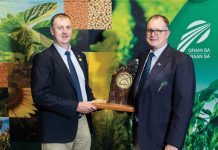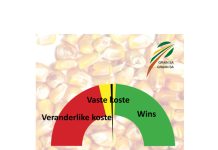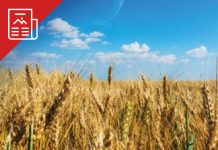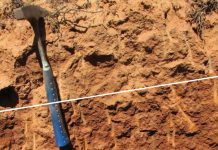The economic value, agricultural and soil conservation benefits of pasture-based livestock production in crop production systems are often underestimated and not well quantified. The enormous pressure on crop production areas to consistently produce good quality crops in a sustainable manner is forever increasing.
Currently, most traditional agricultural practices (on both a small and large scale) lead to severe land degradation and are climate change negative, such as intensive tillage, which often results in greater losses of soil organic matter, poor soil structure and available soil moisture, and increased runoff and soil erosion.
This situation forces land users to consider more sustainable land use options, such as conservation agriculture (CA). CA is an approach to managing farms (or agro-ecosystems) for improved and sustained productivity, increased profits and food security while preserving and enhancing the resource base and the environment.
CA is characterised by three linked principles, which are supposed to be implemented simultaneously, namely:
- Continuous minimum mechanical soil disturbance.
- Permanent organic soil cover.
- Diversification of crop species grown in sequences and/or associations.
In recent decades, the integration of livestock with CA systems was perhaps among the most significant innovations in these mixed production systems to ensure economic and ecological sustainability and resilience while providing ecosystem services, such as increased biological diversity, nutrient cycling and improved soil health.
Livestock on improved pastures derived from CA-based crop-pasture rotations not only produce more meat per unit of pasture, they produce more per unit of greenhouse gas emission. Based on these positive research results and experiences from producers and other practitioners in the world (including the sub-Saharan Africa region) during the last three decades, a new kind of sustainable, intensified agriculture, based on CA, is emerging.
This series of articles to follow in the coming months will highlight some of the pasture crop species that can play an imperative role in CA-based crop-pasture rotations. Besides improving the physical, chemical, hydrological and biological properties of the soil, diversified cropping, including annual or perennial cover crops (one of the main CA principles) can successfully be used as animal feed. Actually, the majority of rotational and cover crop species have already been used as animal feed, probably even before they were known to improve soil properties. Furthermore, the presence of livestock brings an additional source of life to the soil through nutrients, microbes and soil aeration as a result of livestock hoof action.
One of the key factors to consider before selecting a specific pasture species is the suitability of the land (soil, topography and climate) for the cultivation of the specific species.
What land qualities are required for successful cultivation of the species? The next question to consider, is if the species need to provide good quality hay, silage or green feed and what time of the year would this be required?
Other than fodder production and preservation, it can also be asked whether and when the pasture crop needs to be grazed, and if so, which livestock type will utilise the pasture crop? This is extremely important as stocking rates and grazing systems need to be designed accordingly to protect the pasture crop from over- or under-utilisation. This approach should however not be at the cost of economical livestock production if this is regarded as the key driver for utilising pasture.

The following aspects are similarly of key importance when identifying the key pasture crop species for a particular use in CA.
Agro-ecological distribution
The suitability of different agro-ecological regions for cultivating different species is of major importance. The species of interest has to be evaluated to establish its suitability to specific climatic, topographic and soil (land/edaphic) qualities.
Once the suitability is assessed, it can then be decided whether additional ameliorative practices, such as fertilisation, liming or irrigation are required to enhance the production of the selected species. The suitability of species to the aforementioned land qualities will essentially determine to a large extent the forage quality and anti-qualities components expected of the species.
Management and utilisation
To optimally utilise the benefits of a pasture crop, both in the context of contributing to soil health and secondarily the provision of grazing or fodder, the correct establishment, fertilisation, irrigation and weed control practices are instrumental. In this series we will highlight the most important aspects with respect to these management practices for the most common and recommended pasture species.
Once the pasture has been successfully established, the utilisation of the pasture needs to be conducted in such a way that it stimulates the growth of the pasture species, rather than restricting its growth through over-utilisation and consequently damaging the growth points.
The correct stocking rates will play an empirical role in the utilisation of the pasture. These stocking rates will ultimately establish the grazing system required to optimally utilise the pasture and achieve maximum livestock production from the area. The time at which different pastures are to be utilised, will also be highlighted in this series, as this aspect will be used to select the correct pasture crop in rotation and/or for soil conservation strategies.
Management challenges
Some pasture crops are not always the easiest species to establish and in some cases to manage. Nutrient and water management of pasture species can become challenging, especially if an intensive grazing management system is implemented. Often pasture crops fall victim to pest infestations and require some form of management change together with intensive treatment to overcome the situation to heal the pasture crop.
Many times certain uncontrollable environ mental conditions can bring upon certain anti-quality factors which a land user needs to be aware of, as this can be detrimental to the livestock herd’s health and production potential. There often exists situations where fire can have severe effects on the regrowth rate of certain species, and specific management inputs will be required to support such a pasture crop, to achieve its full growth potential at a later stage.
Soil conservation and health benefits
Primarily pastures are planted to produce grazing or fodder, however in integrated CA cropping systems, the main contribution of the pasture should be to conserve and heal the soil for sustainable and profitable crop production.
Many pasture species can fulfil these requirements since most of the species are perennial and have remarkable root systems which facilitate soil health recovery. Very important benefits which pasture crops accentuate include:
- Improving nitrogen for subsequent crops (with legumes)
- Rebuilding soil organic matter and improving soil structure
- The control and management of weeds
- Providing a disease and pest break
- Reducing runoff, soil erosion and deep drainage.
It is however an opportunity for land users to utilise these pasture crops at the same time as this utilisation stimulates both above-ground (stem and leaf) and below ground (root) growth. The secondary benefit of pasture utilisation by livestock, is the importation of nutrients, microbes and additional organic matter through urine and dung. It is also quite common that intensively cultivated soils planted to pasture ley crops experience a degree of surface compaction/crusting in the first year or two depending on the soil type. This surface compaction/crusting can lead to erosion if excessive thunderstorms are experienced, however as a result of hoof impact of grazing animals the surface crust is disturbed and can facilitate better moisture infiltration. In addition to this, plant litter is also trampled into the soil assisting with the decomposition of the material which then contributes to the soil organic matter cycle.
Animal production aspects
Since crop land is being rested or conditioned for future grain crop use (within a long term and diverse CA crop rotation system), the period which these areas are withdrawn from grain production, provide the opportunity to dual purposefully heal (rehabilitate) the soil and utilise the pasture crop simultaneously.
Livestock are the key factor to facilitate and accelerate the aforementioned approach in a profitable manner. Grain producers often have the added advantage of crop residues which can add significant value to a fodder flow programme for a livestock enterprise. It is however imperative that the pasture crops should be managed to achieve good livestock production per hectare rather than production per animal.
Specific pasture crop types and benefits
When selecting a pasture crop to be included into a grain cropping system to support CA principles, it is essential that the pasture crop is selected with a clear understanding of its management requirements and challenges.
Pasture crops vary from warm season and cool season types, they include leguminous crops for biological nitrogen fixation, which consequently result in these pasture crops having a higher forage quality. Certain pasture crops have a higher requirement for water and nutrients and others are more tolerant of poor sandy soils and drier conditions.
Some species are more tolerant of acidic soils and others more tolerant of brackish soils. Winter versus summer seasons provide different challenges, therefore the appropriate selection of a pasture crop to be integrated into a cropping system will depend on the need of the land user.
Conclusion
Integrated crop and pasture-based livestock production systems have enormous potential to support and enhance the principles of CA. If these CA-based crop-pasture rotation systems are designed and implemented appropriately, degraded cultivated soils will recover and improve, providing the critical basis for sustainable crop-livestock intensification.
For more information, contact Dr Wayne Truter at wayne.truter@up.ac.za, Prof Chris Dannhauser at admin@GrassSA.co.za, Dr Hendrik Smith at hendrik.smith@grainsa.co.za or Mr Gerrie Trytsman at gtrytsman@arc.agric.za.

















